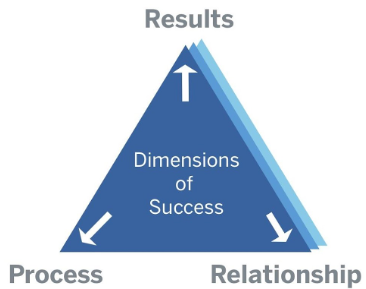Tag Archive: roles
October 20, 2020
Just wrapping up a bit of work with a national network that we at IISC helped to get off the ground 5 years ago, which has seen incredible growth and success in its efforts, and which continues to make progress in these times. For us, what this means is that they have really been hitting on what we call the collaborative dimensions of success – results, process and relationships (see image above). That said, some parts of the network (particular working groups) are humming along more so than others.
In our latest meeting with the network, we helped incubate new working groups (now taking their total to 13!) and also held a gathering of existing working group members to come up with a list of success factors and what they wish they had known at the outset to set themselves up for success. This list will be provided to the new working groups to help them along. I was struck by how many of the items on the list below align with what we teach in Facilitative Leadership for Social Change. While there is no exact recipe for success, we have found over the past 27 years that there are certain practices that create conditions for more likely fluid collaboration. ‘
Here is a list of 27 distinct but related success factors that were identified:
- Diversity; people with different skills and experiences, a diversity of vantage points, ideas, and learning curves.
- Dividing up roles – facilitator, recorder, timekeeper, liaison, etc.
- Willingness to grow and change our roles; not feeling one has to be in the original role.
- Establish group working agreements for collective accountability and be open to changing them as needed.
- Strong facilitation.
- Understanding of the difference between a working group chair and facilitator (these may or may not be the same person).
- Ensure everyone feels like they are able to contribute to group conversations if they want to; check for accessibility issues of various kinds.
- Intervene around those who would otherwise dominate conversation and shut others down.
- Comfort with letting go of an idea once it has been incubated; people understand that when they generate an idea or proposal that it might be changed or critiqued by the rest of the working group, to make it better.
- Loosen grip on ego.
- Have consistent meetings and touch points – monthly or bi-weekly – to keep on track.
- Practice an ethic of love, generosity and forgiveness.
- Open up to bigger sources of inspiration and creativity.
- Build common language; make sure that everyone understands any acronyms or technical terms being used.
- Use a process guide/map for helping working groups in their overall development and work planning; they can adjust as they see fit, but having a framework can be very helpful.
- Have an agenda for your meetings and follow it, until it doesn’t make sense to do so.
- Set desired outcomes each meeting, so you can determine where any conversation or agenda item is heading and when it’s over.
- Make sure your meeting agendas are realistic … put on it what you can actually get to; prioritize and manage the conversation.
- Give people time to connect with one another.
- Check for agreement and/or for clarity around key points before moving on.
- Make sure action items/next steps are captured at the end of each meeting and restated at the top of your minutes/group memory; revisit in your next meeting.
- Conduct process reviews of meetings (what worked, what could be improved); keep what’s working and make changes accordingly.
- Keep easy-to-digest minutes/group memories to maintain momentum; having consistent and capable support around this kind of record keeping, including key agreements and next step.
- Get meeting minutes/group memories out as soon as possible to everyone, including those who may have missed a meeting.
- Support onboarding of new members, so they can catch up easily and step into the flow – think about one-on-one conversations and mentorship.
- Provide easy access to/support around accessing shared documents, tools and platforms.
- Keep group size manageable – 10 is a nice size; if more consider sub-dividing for certain tasks (think in terms of small group ministry).
September 19, 2017
One of the questions that often comes up in our popular workshop, Facilitative Leadership for Social Change goes something like this,
“It’s great that I’m learning all of these practical leadership and facilitation skills, but what happens when I’m not the one leading or facilitating?”
How can we keep things rolling when we aren’t formally in charge and when formal leadership is perhaps not so skillful? My answer: There’s usually some opportunity to lead, ask good questions, and to facilitate from the chair! Read More
April 4, 2017
“You’ve got to keep asserting the complexity and the originality of life, and the multiplicity of it, and the facets of it.”
– Toni Morrison

Once again, I’ve been re-reading Niels Pfleaging’s short book Organize for Complexity (and eager for the release of the English version of Complexitools) amidst the growing demand we are hearing at IISC from people who want to liberate their organizations and themselves to be able to intelligently respond to change and to come back to life! Here’s the gist – as things shift more, and more rapidly, some people’s inclination may be to try to exert greater control or dig in to what is familiar, but does not work. The more one does so, the worse things can get. As Pfleaging writes, we see a “high price for the illusion of control.” Within organizations this takes the form of various gaps – social, functional, and temporal – that make them increasingly irrelevant, ineffective and irresponsible.
Responding to complexity requires (to borrow a phrase from Eugene Eric Kim) new muscles and mindsets.
Read More
March 4, 2015
“You’ve got to keep asserting the complexity and the originality of life, and the multiplicity of it, and the facets of it.”
– Toni Morrison

I’ve been re-reading Niels Pfleaging’s short book Organize for Complexity and appreciating how it succinctly captures the current challenges for many groups and organizations trying to navigate complexity while clinging to old tools and beliefs. This can also be the nature of social change work amidst the significant shifts we are seeing. Here’s the trick – as things shift more, and more rapidly, people’s natural inclination may be to try to exert greater control or dig in to what is familiar but does not work. The more one does so, the worse things can get. As Pfleaging writes, we see a “high price for the illusion of control.” Within organizations this takes the form of various gaps – social, functional, and temporal – that make them increasingly irrelevant and ineffective. Responding to complexity requires (to borrow a phrase from Eugene Kim) new muscles and mindsets.
If I could summarize my own reading of Pflaegings’s book, I would put it this way – the world we are living into requires more integrated ways of seeing and doing, and this is hard to do (if not impossible) if people maintain highly differentiated ways of organizing themselves. There is really a baseline call for self-awareness and mindfulness so that one is able to respond not by default or fear, but with perspective and intention, which connects to the idea of “strengthening the network within” at the individual level. And it is important to reach out and connect this self-awareness to others . . .
“Problem-solving in a life-less system is about instruction. Problem-solving in a living system is about communication.”
-Niels Pflaeging
Read More
October 29, 2014
“Our success is built on partnership, sharing success and sharing credit.”
– Sec. Chuck Ross

“The mojo is in the motto.” With these words, Secretary of Agriculture Chuck Ross opened the doors and conversation on the fourth annual Vermont Farm to Plate Network convening last Thursday in Killington. Each of the past four years Secretary Ross has brought some critical words of encouragement and motivation to this fall convening, and by invoking the state motto – “Freedom and Unity” – at this year’s opening he seemed to hit the right chords at a critical moment in the evolution of the network.
In 2011, Farm to Plate launched to great excitement and some anxiety as it positioned itself as a cross-sector collaborative network to carry out a strategic plan to double local food production in Vermont in 10 years time, contributing to job and economic growth as well as food access in a state that sees high rates of poverty. Since then, as both Ellen Kahler of the Vermont Sustainable Jobs Fund (the backbone organization for Farm to Plate) observed and remarked through a plenary retrospective, it has managed to find its collaborative footing and grow significantly in numbers (more than 300 organizations strong). And importantly, it has seen real results in terms of direct, indirect and induced job growth resulting in 9,000 new jobs in the agricultural and food sector in Vermont. Furthermore, success is evident in individual members using network goals to inform and align their organizational goals. Read More
October 8, 2014

In recent work with a couple of different leadership development programs, I shared a few stories about organizations that failed to recognize the value of informal networks within and beyond their formal boundaries by choosing to see themselves primarily through the lens of the “org chart” and fixed roles/job descriptions (what I sometimes call the “stay in your lane” approach). In these cases what was lost was the ability to access greater organizational potential and intelligence. If we think of organizations as living entities, then our connections within and beyond those cellular walls might be thought of as vital nerves or sensors. When we fail to acknowledge or even cut these connections within, which often represent the pathways through which work actually gets done, we may stymie or destroy critical flows and functioning. And when we fail to see and leverage how people in all roles are connected beyond the organization, then we reduce not only the potential contribution of each individual, but the overall surface area of the organization that might otherwise attune it and help it to respond to larger systemic opportunities or threats. Which is why increasingly people are seeing mechanistic and fixed organizational roles as “irresponsible” – they do not allow people, individually and collectively, to effectively respond to circumstances and activate around that about which they care most. So the invitation is to think and act more like a living network. What are you doing to build greater sensitivity and surface area in your organization or change effort?
August 11, 2014

Photo by Synopia
A number of readings I’ve come across lately reference the important consideration of organizational structure and how it encourages or discourages collaboration. In a post from last week, I highlighted the book Reinventing Organizations by Frederic Laloux, which focuses on “evolutionary (Teal) organizations” that embrace an ethic of self-organization to facilitate more purpose-driven, holistic and responsible engagement on the part of organizational members. In order to encourage self-organization and intrinsic motivation, these entities adopt less formally hierarchical and fixed-role structures in favor of fluidity and networked leadership. According to Laloux, this brings more timeliness and relevance to the inner workings and responsiveness of these organizations. Read More
May 14, 2014

In a number of the social change networks that I am supporting there is very active and interesting conversation, and experimentation, going on around what I would call the process-action tension. As I have written elsewhere, I see this as a bit of a false and often unhelpful dichotomy, and I have certainly seen and been part of networks that have gotten bogged down in some version of analysis paralysis and never-ending consensus building. Increasingly there is a leaning towards getting out there sooner than later and trying things, learning from experiments and actions, readjusting, etc., which is all well and good. At the same time, I see it as part of my role to raise questions about how the embrace of “do-acracy” might have unintended consequences around long-term alignment as well as sustained and truly systemic impact. Read More
December 27, 2012

IISC would like to share our Top 5 most influential post of 2012! Join us until the New Years Eve when we reveal our number 1 blog post!
The following post began as a response to FSG’s lastest contribution to its work around “collective impact” on the Standford Social Innovations Review blog. There is much value in the additional details of this cross-sectoral approach to creating change, and I especially appreciate what is highlighted in this most recent piece regarding the strengths and weaknesses of different kinds of “backbone organizations” to support and steer the work. In the ensuing conversation on the SSIR blog, there is a comment from an FSG staff person about the importance of building trust in launching these efforts, and it was from this point that I picked up . . .
With deep appreciation for the good work of FSG in helping to codify this important approach, I wanted to add that from our experience at the Interaction Institute for Social Change, helping people develop the skills of process design and facilitation is of paramount importance in cultivating trust and ultimately realizing the promise of large-scale multi-stakeholder collaborative efforts. Read More
August 8, 2012

|Photo by Siew Yi Liang|http://www.flickr.com/photos/sonictk/361505937|
One of the comments that often comes up in our popular workshop, Facilitative Leadership goes something like this, “It’s great that I’m learning all of these practical leadership and facilitation skills, but what happens when I’m not the one leading or facilitating?” How can we keep things rolling when we aren’t formally in charge and when formal leadership is not so skillful. My answer today: there’s always an opportunity to lead, ask good questions, facilitate from the chair! Read More
October 31, 2011

Last week, colleagues Andrea Nagel, Jen Willsea and I facilitated the workshop, Fundamentals of Facilitation for Racial Justice Work for staff at the Boston Public Health Commission. One of the most powerful parts of the workshop was an exercise where participants had to listen to a view with which they disagreed without opposing, fixing or leading the speaker to another viewpoint. Challenging, to say the least! It raised a great question about not just how, but when to listen without attempting to shift anything. Like many of the workshop participants, I struggle with this practice, particularly when the speaker’s views fly in the face of realities I see and history I know, or when the very act of listening seems to give comfort to views that diminish my humanity. The struggle brought me back to a classic essay, “The Art of Listening,” by feminist author Brenda Ueland.
Read More
July 21, 2011

|Photo by http2007|http://www.flickr.com/photos/http2007/2204187170|
In this week’s public Pathway to Change workshop in San Francisco, participants engaged in a practice meeting facilitated by some of their colleagues that focused on effective means of building power in collaborative change efforts to enhance their overall effectiveness to realize more just ends. The assumptions going into the conversation were that power is defined as the capacity to influence people and one’s environment, create change, address needs, pursue desires, and/or protect interests. Furthermore we suggested that power is not a fixed asset that people possess. Rather, it is socially constructed, understood, and legitimized through social relationships among individuals and groups of people. Given that it is not fixed, it can also grow or be grown.
So here is the list of ideas that surfaced for ways to build power and we certainly invite your reactions and additions (items in bold ended up being given higher priority by the group): Read More












